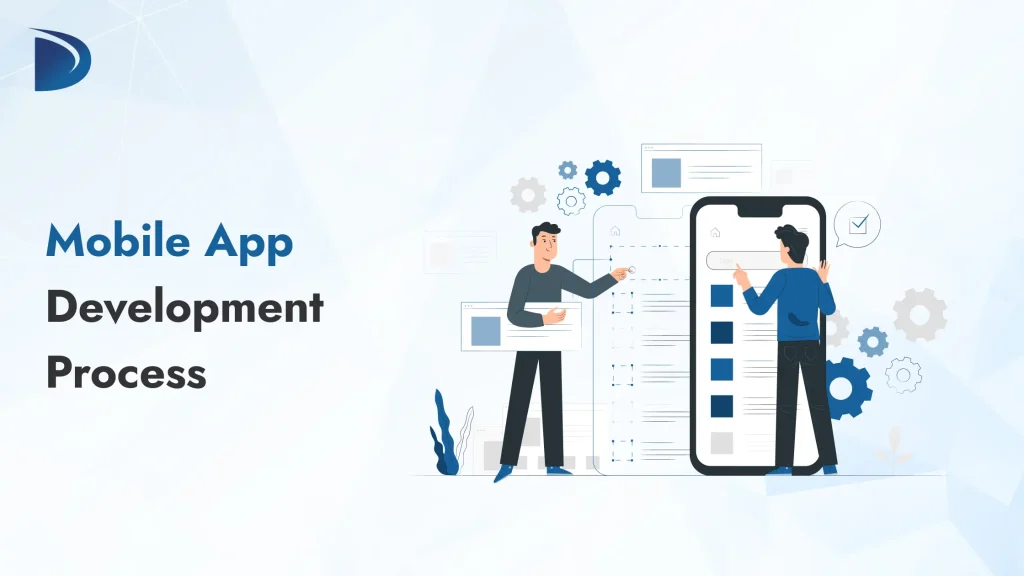Table of Contents
Creating a successful mobile app isn’t just about writing code it’s about solving real problems for users, delivering a seamless experience, and continuously improving to stay relevant. Whether you’re a startup or an enterprise, an expert mobile app development company can save your time, reduce costs, and lead to better outcomes, as they follow only the required process during development.
This guide breaks down each phase of the mobile app development journey, from understanding goals to post-launch growth.
1. Define Goals & Do Market Research
Identify the App’s Purpose
Before anything else, ask:
- What problem does this app solve?
- Who will use it?
- Why would they choose it over others?
Clearly defining the app’s objective helps align development with business outcomes.
Know Your Audience
Understand your target users:
- Age, location, habits, devices
- Needs and pain points
- Behavior patterns
Research the Competition
Look at top apps in your category. Learn from:
- Their features and UI/UX
- What users love and hate (via reviews)
- What gaps you can fill
Pro Tip: If building a food delivery app, analyze how apps like Uber Eats or DoorDash handle features like real-time tracking, loyalty programs, and customer support.
2. Planning & Strategy
Choose the Right Type of App
- Native Apps – Built for iOS or Android; best performance
- Hybrid Apps – One codebase for both platforms; faster to build
- PWAs (Progressive Web Apps) – Web-based apps with mobile features
Choose based on performance needs, budget, and audience.
Select the Technology Stack
Depending on the platform:
- iOS: Swift, Objective-C
- Android: Kotlin, Java
- Cross-platform: Flutter, React Native, Xamarin
- Backend: Node.js, Django, Laravel, Firebase, etc.
Build a Roadmap
- Break the project into phases: Design → Development → Testing → Launch
- Assign roles: developers, designers, QA, project manager
- Use Agile methods for flexibility and faster releases
3. UI/UX Design
Wireframes & Prototypes
- Start with low-fidelity wireframes to plan layout and navigation
- Build clickable prototypes to test usability early
Tools: Figma, Adobe XD, Sketch
UI Design (User Interface)
- Use brand colors, readable fonts, and simple layouts
- Design for various screen sizes
- Follow platform-specific design guidelines
UX Design (User Experience)
- Keep navigation intuitive
- Ensure fast loading and responsiveness
- Follow accessibility standards for all users
4. Development phase
Frontend Development
The visible part users interact with:
- Code based on approved designs
- Ensure responsiveness across devices
- Optimize animations and transitions
Backend Development
Handles business logic, data, and APIs:
- Set up databases, cloud storage, and user authentication
- Use secure and scalable technologies
- Integrate APIs and payment systems
Third-Party Integrations
Enhance functionality with:
- Payment gateways (Stripe, PayPal)
- Social logins (Google, Facebook)
- Push notifications (Firebase, OneSignal)
5. Testing
Testing ensures the app works flawlessly before launch.
Functional Testing
- Check if features work as intended
- Validate across devices, screen sizes, and OS versions
Performance Testing
- Test for speed, battery use, and network performance
- Simulate real-world load conditions
Security Testing
- Ensure data encryption
- Check user authentication & secure APIs
User Acceptance Testing (UAT)
- Get real users to test the app
- Gather feedback and refine before the final release
6. Launch & Deploy
App Store Submission
For iOS:
- Use Apple Developer account + Xcode for submission
- Meet Apple’s strict guidelines
For Android:
- Use Google Play Console
- Submit APK/AAB with required details
App Store Optimization (ASO)
- Use relevant keywords in your title and description
- Add high-quality screenshots and video previews
- Encourage user ratings and reviews
7. Promote the App
Marketing & Promotion
- Create a landing page for SEO
- Leverage social media, influencers, and blogs
- Run targeted ads (Google, Facebook, Instagram)
- Use email campaigns and app install ads
Incentives & Engagement
- Offer discounts, free trials, or referral bonuses
- Use gamification to boost engagement
8. Post-Launch Support & Maintenance
Regular Updates
- Fix bugs
- Add features
- Adapt to new OS updates
Performance Monitoring
- Track crashes, slow load times, or drop-offs
- Use Firebase, Google Analytics, Crashlytics
Continuous Improvement
- Use feedback tools like Hotjar or Typeform
- Analyze behavior to guide new features
- Run A/B tests to improve retention
Conclusion
A well-structured mobile app development process is the key to building a successful, high-performing, and user-friendly application. Every phase, from defining business goals to continuous updates, plays a crucial role in ensuring that the app meets user expectations, market demands, and business objectives.
By following a step-by-step development process, businesses can:
- Reduce development risks and avoid costly mistakes.
- Improve user experience and engagement with intuitive design and smooth functionality.
- Ensure app stability, security, and scalability with rigorous testing and monitoring.
- Stay competitive and relevant through regular updates and feature enhancements.
Investing in a structured and strategic development approach leads to the creation of an app that not only attracts users but also retains them, providing long-term business value and growth.
If you are looking for professional mobile app development, our team at Differenz System can help you bring your vision to life. Contact us today to build an innovative, high-quality mobile app that stands out in the market!
FAQs
What is the Mobile App Development Process?
The mobile app development process involves several stages, from initial concept and planning to design, development, testing, and deployment. It’s essential for creating both Android and iOS mobile apps that are functional and user-friendly.
How long does the app development process usually take?
Typically, the development process can take anywhere from a few weeks to several months, depending on the complexity of the app and whether it’s for Android, iOS, or both platforms. Clear requirements and efficient collaboration can expedite the timeline.
What are the key stages in the Android Mobile App Development Process?
The Android app development generally includes stages like requirement gathering, UI/UX design, development, testing, and deployment, followed by post-launch maintenance to ensure the app runs smoothly on all devices.
How does the iOS Mobile App Development Process differ from Android?
While both processes are similar, the iOS app development process often requires adherence to stricter Apple guidelines and uses different programming languages like Swift or Objective-C, compared to Java or Kotlin for Android.
Why is app testing important in the development process?
Testing is crucial to the app development process as it helps identify bugs and issues before launch, ensuring that both Android and iOS mobile apps provide a seamless user experience across various devices and operating systems.
What factors influence the cost of the mobile app development process?
App complexity, platform choice (Android, iOS, or both), design requirements, and development time frame are key factors that affect the overall cost of the app development process. Working with experienced developers can help manage costs effectively.
Can I update my app after it’s launched?
Absolutely! Updating your app is a normal part of the app development process. Regular updates can introduce new features, improve performance, and ensure compatibility with the latest Android and iOS operating systems.

